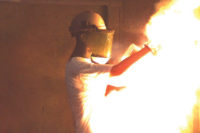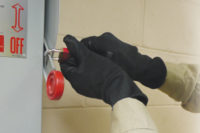Arc flash safety

Most of industry as well as government agencies now are required to comply with OSHA regulations, but some parts of the CFR (Code of Federal Regulations) apply only to specific industries. Standards like 1910.269 have specific arc flash requirements, but it only applies to electric utilities in certain work situations.
For instance, when a utility hires an electrician to work on an office that is not in a substation or other facility blocked from public access, the electrician would fall under general OSHA standards and not the utility specific standard. This method of inclusion and exclusion opens room for interpretation, and when standards do not agree on requirements many companies are left with little guidance on which requirement to follow.
The “apparel standard”
In 1994, OSHA promulgated 29 CFR 1910.269 covering utilities with what became known as the “apparel standard.” This standard required utilities to wear clothing that would not “increase the extent of the injury” in electric arc exposures. It required the use of cover-up barriers, rubber gloves and hot sticks for utility line workers but didn’t really impact electricians. The OSHA language in the hazard assessment standard requiring companies to prevent or protect from “arc flash” had little effect since there were no standard guidelines on how to do that.
In 2000, a new consensus standard was published. Consensus standards do not have the force of law directly, but indirectly OSHA can enforce them. NFPA 70E, Standard for Electrical Safety in the Workplace was designed for industrial electricians’ safety. It has had worldwide impact through its acceptance by U.S. multinationals and will continue to have an effect due to the recent agreement between NFPA and CSA (Canadian Standards Association). CSA is adapting NFPA 70E 2004 and updating it to be similar to NFPA 70E 2009. The Canadian standard will be Z462 and is slated for publication in 2008.
Implementing NFPA 70E 2004 is a good strategy for Canada, and many companies committed to electrical safety are implementing now. NFPA 70E, however, excluded many operations, specifically utilities, communications, railways and mining. Though some operations in those companies are covered by NFPA 70E, such as building maintenance electricians, many are excluded. This gap in coverage and the vagueness of the OSHA utility standard left the need for more clarification for utility-type work. This is now being filled by the NESC 2007 version.
NESC arc flash section
The NESC, National Electrical Safety Code has included a work rules section in this public safety document for several editions. It now has an arc flash section that will change the way utilities look at arc flash protection, but this doesn’t only cover utilities. It covers all contractors who work on transmission, generation and distribution of electricity in a utility-type application. The NESC begins for utilities what OSHA began and NFPA 70E continued for electricians of all sorts. It now requires PPE to protect from the hazard.
NESC 2007 includes “the electric supply conductors and equipment … (including) electric supply stations, that are accessible only to qualified personnel.”
NFPA 70E is more prescriptive than the NESC. It gives tables describing the PPE, while the NESC only requires workers to wear clothing with an “arc rating” equal to the predicted hazard. The NESC has the following important provisions:
• Clothing requirements effective as of January 1, 2009;
• Arc flash assessment calculations required;
• If “exposure greater than 2 cal/cm2” “employer shall require employees to wear clothing … that has an effective arc rating not less than the anticipated level of arc energy”;
• Secondary portions of systems require 4 cal/cm2 PPE, “engineering controls” due to high energies, no arc calculations are required on secondary systems unlike NFPA 70E.
Greater protection
The NESC will lead utilities to much more protection than the current OSHA standard, and recent OSHA proposed language indicates OSHA is planning to implement the NESC 2007 language into law in the future. Calculating arc flash energies for utility work will be critical but it leaves utilities some leeway in certain areas.
The NESC is not prescriptive on clothing design or hood requirements, leaving the market free to design protective systems that are more comfortable and wearable than the NFPA 70E market is currently offered. Though NFPA 70E seems prescriptive this is a bit of a misunderstanding. The tables, which describe Hazard/Risk Categories of PPE, are prescriptive, but companies that do calculations are left with much more freedom than those using the tables. Companies are looking at more comfortable systems and systems that are easier to don and doff in the event of an arc.
No matter what your exposure, these standards will cause you to think about your hazards in new ways. When standards bring out new requirements, companies develop new ways to protect and comply with the standard. Engineering changes and PPE changes will be driving the arc market for quite some time.
Looking for a reprint of this article?
From high-res PDFs to custom plaques, order your copy today!




